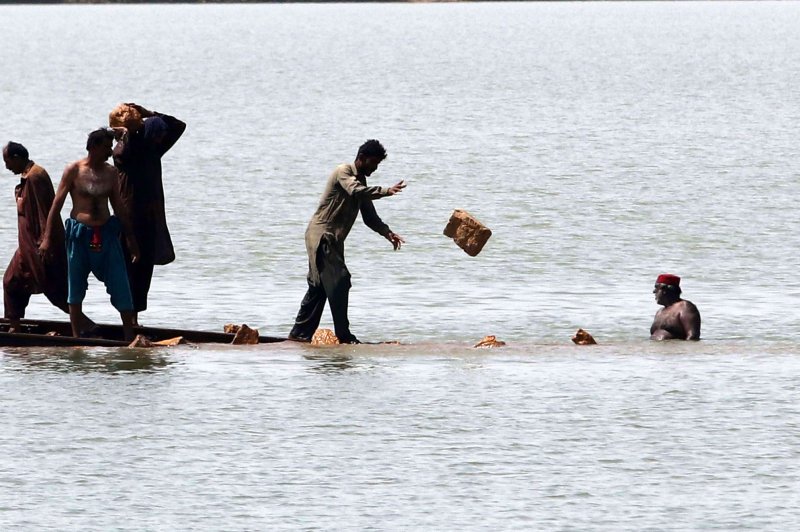
Railroad workers repair a section of track that's been flooded in Sehwan province, Pakistan, on Tuesday. Photo by Rehan Khan/EPA-EFE
Sept. 6 (UPI) -- Severe flooding in Pakistan pushed the country's largest lake to the edge of cresting on Tuesday, threatening a greater disaster in a region where more than 1,300 people have already died since the monsoon season began a few weeks ago.
Located in Sindh province, Lake Manchar is threatening to spill over amid historic flooding that has devastated the Middle Eastern nation for more than two months. The new threat comes after major monsoon rains put large portions of the country underwater.

The military is helping with evacuations and helicopter teams have airlifted hundreds to safety. The military has also been delivering food and critical supplies, but in many cases the aid has been slow to arrive.
Photo by Bilawal Arbab/EPA-EFE
Officials recently made the decision to conduct three controlled water releases from Lake Manchar after flooding in two nearby towns. About 135,000 nearby villagers in rural Dadu and Jamshoro were evacuated.
In all, 33 million people have been impacted by the rains and floodwaters, including 1,300 who have died, according to Pakistan's National Disaster Management Agency. More than $10 million in damage has also been attributed to the severe weather.

Hundreds of tent communities have cropped up across the Pakistani landscape, leading to concerns about the risk for disease to spread in a third-world environment.
Photo by Nadeem Khawar/EPA-EFE
The weather disaster is coming at a bad time for Pakistan, which had already been facing an increasingly fragile economy amid surging inflation and energy costs.
Eyewitnesses throughout the country have described an apocalyptic-level disaster, with people wading through waist-deep water and the destruction of many crops. Hundreds of roads and bridges have been damaged or destroyed and rescuers are trying to remove stranded villagers from inundated homes.ADVERTISEMENT
The military is helping with evacuations and helicopter teams have airlifted hundreds to safety. The military has also been delivering food and critical supplies, but in many cases the aid has been slow to arrive.

Floodwaters are seen in Karachi, Pakistan, on July 11. The country's monsoon season began on July 15 and runs through September.
File Photo by Shahzaib Akber/EPA-EFE
RELATED
Hundreds of tent communities have cropped up across the landscape, leading to concerns about the risk for disease to spread in a third-world environment.
"There is nowhere to shower or go to the bathroom," evacuee Zebunnisa Bibi said according to the Hindustan Times.
More help from the United Nations is expected. Last week, U.N. Secretary-General Antonio Guterres announced efforts to raise $160 million in emergency aid for Pakistan.
The International Monetary Fund has said it would put up $1.17 billion from a 2019 bailout agreement to keep Pakistan from defaulting on its national debt.
No comments:
Post a Comment